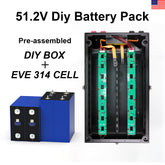What Is The Difference Between Group 31 and Group 34
When selecting a battery for your vehicle, RV, boat, or any other heavy-duty application, one of the most common decisions you'll encounter is whether to choose a Group 31 or Group 34 battery. Both of these battery types are designed for high-performance applications, but they have distinct differences in size, capacity, and suitability for various uses. In this article, we will explore what sets Group 31 and Group 34 batteries apart, helping you make an informed decision for your power needs.
Group 31 and Group 34 batteries are commonly used in vehicles, boats, RVs, and off-grid solar applications due to their reliable performance. While both serve similar purposes, they are optimized for different applications. Understanding the differences between these two battery groups is essential for choosing the right one to meet your energy demands. We will delve into their specifications, advantages, and applications to help you make the best choice for your needs.
- Group 31 and Group 34 Batteries: An Overview
- Key Differences Between Group 31 and Group 34 Batteries
- Which Battery Should You Choose?
Group 31 and Group 34 Batteries: An Overview
Both Group 31 and Group 34 batteries fall under the category of lead-acid batteries, which are commonly used for high-power applications. These batteries are known for their deep cycle capabilities, which allow them to discharge and recharge repeatedly without significant wear. Despite their similarities, they differ in terms of size, capacity, and specific use cases.
Group 31 Batteries
Group 31 batteries are larger and generally offer higher capacity compared to Group 34 batteries. These batteries are commonly used in heavy-duty vehicles like trucks, RVs, and commercial vehicles that require a reliable power source for starting and deep-cycle applications. A typical Group 31 battery is designed to deliver around 100-150 Ah (amp-hours), which makes it suitable for powering larger systems or vehicles with high electrical demands.
The dimensions of a Group 31 battery typically measure about 13 inches in length, 6.8 inches in width, and 9.4 inches in height. These larger dimensions allow Group 31 batteries to house more lead plates, increasing their ability to store and supply more energy over longer periods.
Group 34 Batteries
Group 34 batteries, on the other hand, are slightly smaller and more compact than Group 31 batteries. They are ideal for mid-sized vehicles and applications that do not require as much power storage. A typical Group 34 battery delivers around 50-75 Ah, making it suitable for vehicles or equipment that need reliable starting power but not as much deep-cycle energy.
The dimensions of a Group 34 battery are typically around 10.25 inches in length, 6.8 inches in width, and 7.5 inches in height. While smaller in size, Group 34 batteries still provide sufficient power for a variety of applications and are especially popular for use in consumer vehicles like cars, SUVs, and smaller boats.
>>See also What Is The Value Of A Dead Battery
Key Differences Between Group 31 and Group 34 Batteries
When comparing Group 31 and Group 34 batteries, several key factors come into play, including size, capacity, applications, and performance. Understanding these differences is crucial for selecting the right battery for your needs.
1. Size and Dimensions
As mentioned earlier, one of the most significant differences between Group 31 and Group 34 batteries is their size. Group 31 batteries are larger and designed to fit vehicles and equipment that require more power storage, while Group 34 batteries are more compact and designed for smaller applications.
Group 31 Battery Dimensions
- Length: 13 inches
- Width: 6.8 inches
- Height: 9.4 inches
Group 34 Battery Dimensions
- Length: 10.25 inches
- Width: 6.8 inches
- Height: 7.5 inches
The size difference means that Group 31 batteries take up more space, so if you are working with limited space, a Group 34 battery may be more appropriate.
2. Capacity and Performance
The capacity of a battery is measured in amp-hours (Ah), which indicates how much charge a battery can store and how long it can supply power before needing to be recharged. Group 31 batteries are typically rated for around 100-150 Ah, while Group 34 batteries offer a lower capacity of about 50-75 Ah.
This capacity difference means that Group 31 batteries can provide more sustained power, making them ideal for larger vehicles, RVs, or boats with more demanding electrical systems. If you need a battery to handle deep cycling—such as for extended off-grid power or for systems that require long periods of power supply—Group 31 is the better choice.
Group 34 batteries, with their smaller capacity, are better suited for vehicles and equipment that require short bursts of power, such as starting a car or small boat engine. They also perform well in applications where the electrical load is not as demanding, such as for lighter-duty RVs or smaller vehicles.
3. Applications
Both Group 31 and Group 34 batteries are used in a wide range of applications, but the specific requirements of each application will determine which battery is more appropriate.
Group 31 Battery Applications
- Heavy-duty trucks and commercial vehicles
- RVs with high electrical demands
- Large boats or yachts
- Off-grid solar systems with larger power storage needs
- Military and emergency vehicles
Group 34 Battery Applications
- Consumer vehicles (cars, SUVs, trucks)
- Smaller boats and marine applications
- Motorcycles and ATVs
- Small RVs and camper vans
- Lawn and garden equipment
4. Cost and Value
Due to their larger size and higher capacity, Group 31 batteries tend to be more expensive than Group 34 batteries. However, the added cost may be justified if you require a larger capacity for extended use in heavy-duty applications.
Group 34 batteries, being smaller and offering less power capacity, are generally more affordable. This makes them a good option for those with lighter power needs who don't require the high capacity offered by a Group 31 battery.
5. Weight
Given their larger size, Group 31 batteries are typically heavier than Group 34 batteries. A Group 31 battery can weigh anywhere between 60 to 80 pounds, while Group 34 batteries usually weigh around 40 to 50 pounds. The increased weight of a Group 31 battery is a consideration for applications where weight is a concern, such as for certain RVs or boats where every pound matters.
>>See also How Solar Panel Efficiency And Prices Have Evolved Over Time
Which Battery Should You Choose?
Choosing between a Group 31 and Group 34 battery ultimately depends on your specific needs. If you have a larger vehicle, RV, or boat with high electrical demands, a Group 31 battery is likely the best choice. On the other hand, if you're working with a smaller vehicle, motorcycle, or lighter-duty application, a Group 34 battery may be the better option due to its smaller size and more affordable price.
When deciding between Group 31 and Group 34 batteries, consider the following factors:
- Power Demand: Choose Group 31 for high-power applications and Group 34 for moderate power demands.
- Available Space: Group 31 batteries are larger, so ensure you have enough space for installation.
- Weight Constraints: Group 34 batteries are lighter, making them ideal for weight-sensitive applications.
- Budget: Group 34 batteries are typically less expensive, making them a cost-effective option for those with lower power needs.
Both Group 31 and Group 34 batteries offer reliable power solutions for different types of vehicles, boats, and off-grid systems. While Group 31 batteries are larger, offer more capacity, and are ideal for heavy-duty applications, Group 34 batteries are smaller, lighter, and better suited for less demanding power needs.
Choosing between these two types of batteries comes down to understanding your specific needs in terms of capacity, space, weight, and budget. By considering all these factors, you can make the right choice for your power requirements, ensuring your vehicle or system runs efficiently and reliably.
Remember, whether you choose a Group 31 or Group 34 battery, understanding their differences and selecting the right one for your application will ensure that your power needs are met effectively and affordably.
























Leave a comment
All blog comments are checked prior to publishing